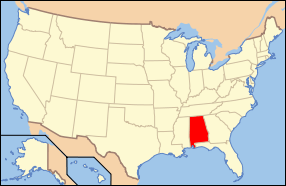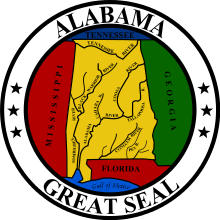Pickens County, Alabama
| Pickens County, Alabama | |
|---|---|
 Pickens County Courthouse in Carrollton | |
 Location in the U.S. state of Alabama | |
 Alabama's location in the U.S. | |
| Founded | December 20, 1820 |
| Named for | Andrew Pickens |
| Seat | Carrollton |
| Largest city | Aliceville |
| Area | |
| • Total | 890 sq mi (2,305 km2) |
| • Land | 881 sq mi (2,282 km2) |
| • Water | 8.7 sq mi (23 km2), (1.0%) |
| Population (est.) | |
| • (2015) | 20,864 |
| • Density | 22/sq mi (8/km²) |
| Congressional district | 7th |
| Time zone | Central: UTC-6/-5 |
| Website |
www |
|
Footnotes:
| |
Pickens County is a county of the U.S. state of Alabama. As of the 2010 census, the population was 19,746.[1] Its county seat is Carrollton.[2] It is a prohibition, or dry county, although the communities of Carrollton and Aliceville voted to become wet in 2011 and 2012, respectively.
Pickens County is included in the Tuscaloosa, AL Metropolitan Statistical Area
History
Pickens County was established on December 20, 1820, and named for revolutionary war hero General Andrew Pickens of South Carolina. The county seat was relocated from Pickensville to Carrollton in 1830. The first courthouse in Carrollton was burned on April 5, 1865, by troops of Union General John T. Croxton.
It was developed for cotton plantations, worked by a large population of African-American slaves brought south in the slave trade.
A second courthouse was destroyed by fire on November 16, 1876, during the last months of the Reconstruction era. Though arson was suspected, no arrest was made until January 1878, after white Democrats had regained control of the state legislature. Henry Wells, an African American with some criminal history, was arrested as a suspect in the arson and locked in the garrett of the new building, which had been erected in 1877. According to legend, Wells was peering down from the north garrett window as a lynch mob gathered to hang him, not waiting for a court trial, although only white men were selected for juries. Through the end of the 19th and into the early 20th century, the rate of lynchings went up across the South as Democrats tried to impose white supremacy.
A bolt of lightning struck nearby and "etched" Wells' anguished face into the window glass. A vague image resembling a face can still be seen in that lower right-hand pane of that window. Also see: Pickens County Courthouse.
According to a 2015 study of lynchings across the South, Pickens had 15 such murders from 1877 to 1950 (with most closer to the beginning of the 20th century. It ranks with Bibb and Dallas counties as having the third-highest number of lynchings in the state of Alabama.[3]
20th century to present
On April 8, 1998, a supercell thunderstorm produced an F3 tornado in Pickens County. This windstorm injured two people and damaged five homes including mobile homes. It rotated seventeen miles (27 km) from Holman to north of Northport. Twenty-four homes and thirteen mobile homes were also in the path of destruction. Moments later, that same supercell thunderstorm produced an F5 tornado that struck northeastern Tuscaloosa near the Black Warrior River before entering western Jefferson County where it destroyed Oak Grove High School and killed thirty-two people in its path.
From 2000 to 2013 the rural county had been losing population. From July 2013 to July 2014 the population grew by 5.1%, making it the fourth-fastest growing county with at least 10,000 inhabitants. In 2014 it became the fastest growing county in Alabama. This was due to the installation of the Federal Correctional Institution, Aliceville federal women's prison.[4]
Geography
According to the U.S. Census Bureau, the county has a total area of 890 square miles (2,300 km2), of which 881 square miles (2,280 km2) is land and 8.7 square miles (23 km2) (1.0%) is water.[5]
The county is between Tuscaloosa County and the Alabama-Mississippi state line.[4]
Adjacent counties
- Lamar County (north)
- Fayette County (northeast)
- Tuscaloosa County (east)
- Greene County (southeast)
- Sumter County (south)
- Noxubee County, Mississippi (southwest)
- Lowndes County, Mississippi (west)
Transportation
Major highways
Rail
Demographics
| Historical population | |||
|---|---|---|---|
| Census | Pop. | %± | |
| 1830 | 6,622 | — | |
| 1840 | 17,118 | 158.5% | |
| 1850 | 21,512 | 25.7% | |
| 1860 | 22,316 | 3.7% | |
| 1870 | 17,690 | −20.7% | |
| 1880 | 21,479 | 21.4% | |
| 1890 | 22,470 | 4.6% | |
| 1900 | 24,402 | 8.6% | |
| 1910 | 25,055 | 2.7% | |
| 1920 | 25,353 | 1.2% | |
| 1930 | 24,902 | −1.8% | |
| 1940 | 27,671 | 11.1% | |
| 1950 | 24,349 | −12.0% | |
| 1960 | 21,882 | −10.1% | |
| 1970 | 20,326 | −7.1% | |
| 1980 | 21,481 | 5.7% | |
| 1990 | 20,699 | −3.6% | |
| 2000 | 20,949 | 1.2% | |
| 2010 | 19,746 | −5.7% | |
| Est. 2015 | 20,864 | [6] | 5.7% |
| U.S. Decennial Census[7] 1790–1960[8] 1900–1990[9] 1990–2000[10] 2010–2015[1] | |||
As of the 2010 United States Census, there were 19,746 people in the county. 56.3% were White, 41.6% Black or African American, 0.2% Asian, 0.1% Native American, 0.6% of some other race and 1.2% of two or more races. 1.6% were Hispanic or Latino (of any race).
As of the census[11] of 2000, there were 20,949 people, 8,086 households, and 5,789 families residing in the county. The population density was 24 people per square mile (9/km2). There were 9,520 housing units at an average density of 11 per square mile (4/km2). The racial makeup of the county was 55.95% White, 42.96% Black or African American, 0.12% Native American, 0.11% Asian, 0.02% Pacific Islander, 0.22% from other races, and 0.63% from two or more races. About 0.70% of the population were Hispanic or Latino.
There were 8,086 households, out of which 32.60% had children under the age of 18 living with them, 49.80% were married couples living together, 18.20% had a female householder with no husband present, and 28.40% were non-families. Nearly 26.40% of all households were made up of individuals, and 12.50% had someone living alone who was 65 years of age or older. The average household size was 2.56, and the average family size was 3.11.
In the county, the population was spread out with 27.30% under the age of 18, 8.50% from 18 to 24, 25.80% from 25 to 44, 22.80% from 45 to 64, and 15.70% who were 65 years of age or older. The median age was 37 years. For every 100 females, there were 88.10 males. For every 100 females age 18 and over, there were 83.30 males.
The median income for a household in the county was $26,254, and the median income for a family was $32,938. Males had a median income of $28,843 versus $20,569 for females. The per capita income for the county was $13,746. About 20.10% of families and 24.90% of the population were below the poverty line, including 34.30% of those under age 18 and 22.30% of those age 65 or over.
Government
| Year | GOP | DNC | Others |
|---|---|---|---|
| 2016 | 57.2% 5,454 | 41.6% 3,972 | 1.2% 114 |
| 2012 | 53.3% 5,119 | 46.4% 4,448 | 0.3% 32 |
| 2008 | 54.0% 5,434 | 45.6% 4,634 | 0.4% 39 |
| 2004 | 56.6% 5,170 | 42.9% 3,915 | 0.5% 47 |
| 2000 | 50.4% 4,306 | 48.5% 4,143 | 1.1% 91 |
Communities
Cities
Towns
- Carrollton (county seat)
- Ethelsville
- Gordo
- McMullen
- Memphis
- Pickensville
Census-designated places
Unincorporated communities
See also
- National Register of Historic Places listings in Pickens County, Alabama
- Properties on the Alabama Register of Landmarks and Heritage in Pickens County, Alabama
Notes
- 1 2 "State & County QuickFacts". United States Census Bureau. Retrieved May 17, 2014.
- ↑ "Find a County". National Association of Counties. Retrieved 2011-06-07.
- ↑ "Supplement: Lynchings by County/ Alabama: Pickens", 2nd edition, from Lynching in America: Confronting the Legacy of Racial Terror, 2015, Equal Justice Institute, Montgomery, Alabama
- 1 2 Kirby, Brendan. "How a prison made rural Alabama area one of America's fastest-growing counties" (Archive). Al.com. March 26, 2015. Updated April 30, 2015. Retrieved on December 30, 2015.
- ↑ "2010 Census Gazetteer Files". United States Census Bureau. August 22, 2012. Retrieved August 22, 2015.
- ↑ "County Totals Dataset: Population, Population Change and Estimated Components of Population Change: April 1, 2010 to July 1, 2015". Retrieved July 2, 2016.
- ↑ "U.S. Decennial Census". United States Census Bureau. Retrieved August 22, 2015.
- ↑ "Historical Census Browser". University of Virginia Library. Retrieved August 22, 2015.
- ↑ Forstall, Richard L., ed. (March 24, 1995). "Population of Counties by Decennial Census: 1900 to 1990". United States Census Bureau. Retrieved August 22, 2015.
- ↑ "Census 2000 PHC-T-4. Ranking Tables for Counties: 1990 and 2000" (PDF). United States Census Bureau. April 2, 2001. Retrieved August 22, 2015.
- ↑ "American FactFinder". United States Census Bureau. Retrieved 2011-05-14.
- ↑ "Dave Leip's Atlas of U.S. Presidential Elections". Retrieved November 21, 2016.
References
- Windham, Kathryn Tucker (1969). 13 Alabama Ghosts and Jeffrey. Strode. ISBN 0-87397-008-X..
External links
- Genealogical and Historical Web Site
- Pickens County map of roads/towns (map © 2007 Univ. of Alabama).
- Pickens County article, Encyclopedia of Alabama
- Pickens County, Alabama Sheriff's Office
 |
Lowndes County, Mississippi | Lamar County | Fayette County |  |
| |
Tuscaloosa County | |||
| ||||
| | ||||
| Noxubee County, Mississippi | Sumter County | Greene County |
Coordinates: 33°16′43″N 88°05′35″W / 33.27861°N 88.09306°W
